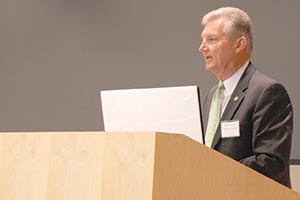Senior Reporter
Va. Transportation Chief Layne Says He’s a ‘Big Believer’ in P3s

This story appears in the May 1 print edition of Transport Topics.
ARLINGTON, Va. — When he first took office in 2014, Virginia Transportation Secretary Aubrey Layne said he wanted to ensure politics would not guide his agency on how to choose and fund infrastructure projects, including sometimes unpopular public- private partnerships.
“I really wanted to be nonpolitical to the extent that I could work with both sides in coming up with solutions in transportation,” Layne told transportation executives April 25. “Also, I wanted to see how far I could take business principals in this process of allocating scarce resources.”
Public-private partnerships, an alternative funding source for infrastructure projects, was the subject of an all-day session at George Mason University.
“I’m a big believer in P3s,” Layne said, “but very rarely, in a P3, is it a replacement for the public investment.”
Transportation leaders should not turn to P3s when their agencies lack money to invest in big-ticket projects, he said.
“That is not the way to look at P3s,” Layne said. “We should look at P3s as leveraging private investment when it is in the best interest of the taxpayer. The only way I know to do that is to first determine what it would cost the commonwealth to do the project and then determine if we bring in private equity and leveraging that is in the best interest of the taxpayers.”
That was the basis of a decision for the Virginia Department of Transportation to do a P3 agreement intended to reduce congestion along Interstate 66, which connects Washington, D.C., to Arlington and Fairfax counties.
“I think a lot of times public- private partnerships are seen as a bit of a stand-alone, instead of a part of a greater whole,” Layne said.
The university’s fourth-annual P3 conference showcased investors and experts in the design and advancement of projects produced with private capital.
Amando Madan, senior vice president of Skanska Infrastructure Development, said P3 proponents need to improve how they promote the system’s funding structure. Critics often dominate headlines pointing to potential drawbacks, such as when people are “opposed to tolling, not the P3 concept,” he said.
Javier Tamargo, CEO of I-77 Mobility Partners, a firm developing express toll lanes along that interstate in partnership with the North Carolina Department of Transportation, emphasized the structure’s significance in reducing congestion. Cities are unable to draft plans and fund transformative transportation grids alone. The expertise of private firms often is required.
“It’s more important to consider P3s as the most efficient [way] of delivery of a transportation project,” Tamargo said.
Funding uncertainty at the federal level has prompted cities and states to partner with investors on infrastructure projects, said Jennifer Mayer, an infrastructure finance consultant with research firm Living Cities.
“There’s a lot of talk about infrastructure. Not a lot of security that anything is going to happen,” Mayer said.
A common P3 consists of private capital that realizes a profit for investors through dedicated debt payments or tolls. Myriad states have launched P3s and tolls to pay for highway projects. Virginia officials approved express lanes on the Capital Beltway, known as “hot lanes.” Florida and Texas enacted legislation facilitating the use of P3s.
Rhode Island is proceeding with a plan to toll trucks to fix deficient bridges.
Pittsburgh, St. Paul, Minn., San Francisco and Washington are exploring P3 opportunities.
Staff Reporter Eugene Mulero contributed to this article.

